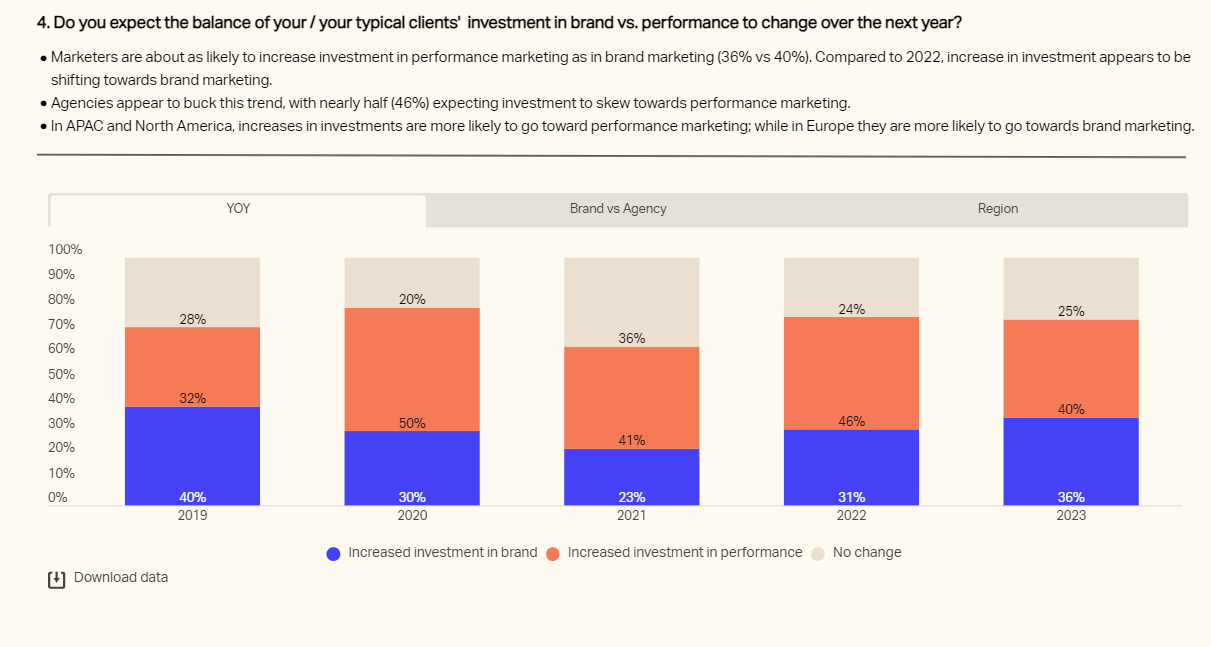Performance marketing’s huge growth has been a result of its appeal as a measurable, targeted strategy. However, the growth of AI, move away from cookie-based measurement, a focus on the importance of long-term effects, and the rise of retail media, are all impacting what performance marketing means today, explains Catherine Driscoll, introducing a new deep dive into the next phase of performance marketing.
Advertisers spend around half of their investment on performance activities, with that proportion having increased since the the pandemic according to WARC research, making it a fitting topic for the latest WARC Guide: Performance Marketing.

In this report, we define performance marketing as a type of online advertising where advertisers pay for specific results, such as clicks and conversions.
However, definitions are malleable, and many previous best practices around performance marketing are changing with the increase in addressable and shoppable media, and the growth of retail media - explored in articles by Jared Belsky, CEO of Acadia and Andrew Lipsman of Media, Ads + Commerce.
Focus on automation: The way performance marketing channels are used is also evolving with the impact of AI on search, and the increasing use of social channels for search. Magdalena Cunnington and Gabriel Matwiejczyk, Marketing Science Partners at Meta look at how best to integrate automation into a performance campaign - TLDR: Don’t run before you can walk.
Balancing the short term with the long: Typically, the focus of performance marketing is sales in the short term rather than brand awareness, and in the Guide we explore how best to fit performance in the full marketing mix for optimal efficiency and effectiveness. In Beyond performance marketing: strategies to maximise performance across the funnel, Gabriella Munro, Inessa Ishunkina, Konstanze Fichtner, and Harry Davison, of Meta, explain how brands can benefit from tapping into broader audiences to boost the outcomes of their direct response marketing.
Changes towards more privacy centric tracking, and awareness of the need to consider longer-term results mean that best practice strikes a balance of approaches. Steve Lockwood Head of Client Research, Europe, at TikTok calls on advertisers to re-evaluate their measurement strategies and be more outcome-focused, while Snezhina Kashukeeva, Customer Success, at Fospha shares some of the difficulties advertisers may face with current strategies and offers advice on how to optimise results.
Attribution retains a key role, but MMM and experiments are needed to gain a complete view of impact. In the report, we have contributions on how to employ MMM from Grace Kite and Charles Cleasby at Magic Numbers, as well as Olivier Kuziner, William Ferrell, and Jean Wu, from Ekimetrics APAC.
Experiments have become crucial for advertisers to optimise their strategies and maximise results within and between channels. Authors from Meta, iProspect and the luxury jewellery brand Pandora, share detail on how to set up effective experiments and share an inspiring case study showing how Pandora created a test and learn culture that resulted in growing incremental sales on Meta by 160% .
Achieving a holistic view of all marketing activity in the short and long term is no mean feat, but Kamran Asghar, Co-founder and CEO of Crossmedia explains the benefits to the bottom line of integtrating all elements of campaign conception, management and measurement.
Value over volume: We also explore some tactics for improving the effectiveness of performance marketing including how to adapt signalling to make it work for high-value products and services from Prassath Leelakrishnan, VP of Consumer at Ethos, and Tamara Bos and Jonny Protheroe from Google share how to improve a website to build shopper confidence.
Last but absolutely not least, Vicky Foster, VP Global Commercial Partnerships at Adform, considers the huge problem of digital advertising’s carbon footprint and suggests how all players in the advertising ecosystem can make progress on tackling this critical issue.
So, there’s an impressive collection of articles to get stuck into, and the report itself is full of insights and inspiration for different sizes and types of brands looking to improve their performance.

